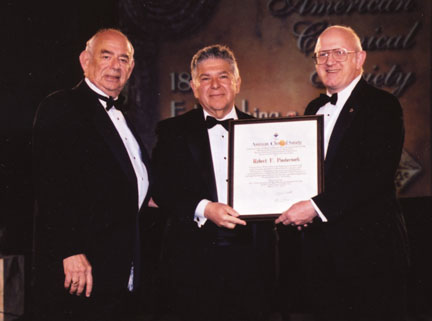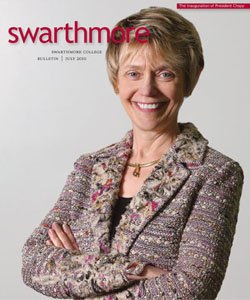Faculty Retirement: Robert Pasternack
Undeniable Chemistry

In April 2001, Robert Pasternack (center) received the American Chemical Society Award for Research at an Undergraduate Institution.
Edmund Allen Professor of Chemistry and Biochemistry Robert “Bob” Pasternack arrived for his final interview at Swarthmore in a snowstorm in 1982. With planes grounded due to the weather in Ithaca, where he was the Charles A. Dana Professor of Chemistry at Ithaca College, N.Y., he traveled to Philadelphia by Greyhound bus. Peter Thompson—now Professor Emeritus of Chemistry—and his wife picked Pasternack up and took him to The Clam Tavern in Clifton Heights—not “the greatest restaurant,” Thompson says, but the meal is memorable for Thompson for its being the start of a long-lasting friendship that still endures between the two chemists.
This year, Pasternack, 74, retires after 28 years at Swarthmore. His research in the field of bioinorganic chemistry has focused on porphyrin chemistry, supramolecular assemblies based on weak interactions, rapid kinetics, spectroscopic methods, and resonance light scattering. Having taught and given talks at colleges, universities, and conferences worldwide, he is the author or co-author of 119 scholarly publications, many in collaboration with his students. He is the recipient of many honors and awards.
The modest Pasternack does not like to talk about himself and declined to be interviewed for this article. On the other hand, chemistry scholars around the world are unrestrained in their words of praise and affection about their teacher, colleague, and friend.
Peter Thompson continues: “Bob is a really nice person to work with and easily one of the most distinguished scientists the College has ever had.”
As a teacher, Pasternack was the consummate storyteller, says Ginger Indivero, a lecturer in chemistry and biochemistry. “Whether delivering a lecture in general chemistry that he had given many times before or presenting a research project for the first time, Bob made it seem like it was the most interesting story that could be told.”
Professor of Chemistry Tom Stephenson was awed as a young professor new to Swarthmore by Pasternack’s energy and enthusiasm for teaching freshmen: “For years, Bob was the mainstay of teaching general chemistry. He’s a remarkable lecturer—organized, clear, dynamic, with a real sense of enthusiasm about what he’s teaching.”
Jonas Goldsmith ’96, former honors chemistry student and now assistant professor at Bryn Mawr College, agrees, especially after taking Pasternack’s inorganic chemistry course as a sophomore. “He’s one of those one-in-a-million teachers,” Goldsmith says. “I still have the notes from that sophomore class on my shelf and still use them. That’s my gold standard for what a class ought to be. And he’s so darned happy!”
On the other hand, Goldsmith continues, Pasternack was a rigorous, demanding teacher. Goldsmith recalls the spring of his senior year, when his mind was on more relaxing endeavors than drafts of his senior thesis.
“I knew my work was not first rate. He gave me back a section, where he’d taken a fat, red marker and crossed out every single line of a page and a half. He didn’t just put an X through it. Every line was crossed out! You can imagine, that makes an impression.”
Miriam Freedman ’00, an assistant professor of chemistry at Penn State University, worked in Pasternack’s lab on her undergraduate thesis and was impressed by his ability to find a balance between supervising his students and allowing them the freedom to explore their own areas of interest. “He broke a huge project into tractable pieces so each student who worked in his lab could tackle a smaller question and take ownership of his/her project,” she says.
Pasternack’s knack for enjoying work and life have touched those who know him both in this country and abroad. Professor of Chemistry Koji Kano of Doshisha University in Kyoto, Japan, has been friends with Pasternack for 26 years. After publishing an article whose conclusion differed from that in one of Pasternack’s publications, Kano was initially nervous about meeting him. Pasternack’s humanity and intelligence quickly swayed him. “I learned a lot from Bob about chemistry—and music, food, human relationships, and other things,” he says. “Bob visited our university as a special visiting professor. Many students and staff members became his fans.”
Liliya Yatsunyk, a young assistant professor of chemistry at Swarthmore who shares Pasternack’s research interests, appreciates his kindness and willingness to help her and is amazed by his frequent presence in the department despite being semiretired.
“It’s very refreshing to see how you can be at the end of your academic career but still so excited. It’s rewarding for me to know that the future can remain so bright,” Yatsunyk says.
 Email This Page
Email This Page
September 12th, 2011 10:13 pm
I was one of Bob's first students at Ithaca College and can only echo the tributes that others have mentioned. He was a key influence in my decision to obtain a PhD in inorganic chemistry [although I later left the specialty for clinical chemistry!]. His instruction in scientific discipline has been one of the important lessons in my career — helping in both accomplishments and pleasures!
I tied to locate Bob two years ago [little success for reasons unknown!] when I read a column in Scientific American about CP Snow {http://www.scientificamerican.com/article.cfm?id=an-update-on-cp-snows-two-cultures}. The significance is that Bob was the initiator of the "CP Snow Series" at Ithaca College, a pivotal introduction for science and 'liberal art' students to work towards bridging the gap between them and effect change. Unfortunately, the article did not mention the series, but I recalled it instantly and who was instrumental in its creation.
My best wishes to a much loved mentor who I think of often!! I hope this note gets to him …